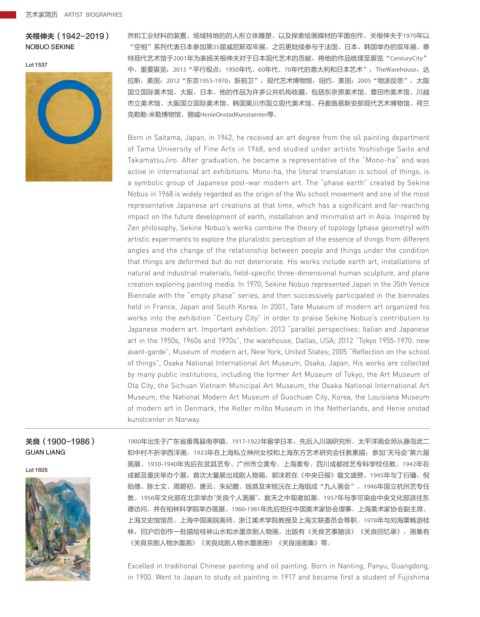Page 238 - 二十世纪及当代艺术
P. 238
艺术家简历 ARTIST BIOGRAPHIES
关根伸夫(1942-2019) 然和工业材料的装置、场域特地的的人形立体雕塑、以及探索绘画媒材的平面创作。关根伸夫于1970年以
NOBUO SEKINE “空相”系列代表日本参加第35届威尼斯双年展,之后更陆续参与于法国、日本、韩国举办的双年展。泰
特现代艺术馆于2001年为表扬关根伸夫对于日本现代艺术的贡献,将他的作品梳理至展览“CenturyCity”
Lot 1537
中。重要展览:2013“平行观点:1950年代、60年代、70年代的意大利和日本艺术”,TheWarehouse,达
拉斯,美国;2012“东京1955-1970:新前卫”,现代艺术博物馆,纽约,美国;2005“物派反思”,大阪
国立国际美术馆,大阪,日本。他的作品为许多公共机构收藏,包括东京原美术馆、豊田市美术馆、川越
市立美术馆、大阪国立国际美术馆、韩国果川市国立现代美术馆、丹麦路易斯安那现代艺术博物馆、荷兰
克勒勒-米勒博物馆、挪威HenieOnstadKunstsenter等。
Born in Saitama, Japan, in 1942, he received an art degree from the oil painting department
of Tama University of Fine Arts in 1968, and studied under artists Yoshishige Saito and
TakamatsuJiro. After graduation, he became a representative of the “Mono-ha” and was
active in international art exhibitions. Mono-ha, the literal translation is school of things, is
a symbolic group of Japanese post-war modern art. The “phase earth” created by Sekine
Nobuo in 1968 is widely regarded as the origin of the Wu school movement and one of the most
representative Japanese art creations at that time, which has a significant and far-reaching
impact on the future development of earth, installation and minimalist art in Asia. Inspired by
Zen philosophy, Sekine Nobuo’s works combine the theory of topology (phase geometry) with
artistic experiments to explore the pluralistic perception of the essence of things from different
angles and the change of the relationship between people and things under the condition
that things are deformed but do not deteriorate. His works include earth art, installations of
natural and industrial materials, field-specific three-dimensional human sculpture, and plane
creation exploring painting media. In 1970, Sekine Nobuo represented Japan in the 35th Venice
Biennale with the “empty phase” series, and then successively participated in the biennales
held in France, Japan and South Korea. In 2001, Tate Museum of modern art organized his
works into the exhibition “Century City” in order to praise Sekine Nobuo’s contribution to
Japanese modern art. Important exhibition: 2013 “parallel perspectives: Italian and Japanese
art in the 1950s, 1960s and 1970s”, the warehouse, Dallas, USA; 2012 “Tokyo 1955-1970: new
avant-garde”, Museum of modern art, New York, United States; 2005 “Reflection on the school
of things”, Osaka National International Art Museum, Osaka, Japan. His works are collected
by many public institutions, including the former Art Museum of Tokyo, the Art Museum of
Ota City, the Sichuan Vietnam Municipal Art Museum, the Osaka National International Art
Museum, the National Modern Art Museum of Guochuan City, Korea, the Louisiana Museum
of modern art in Denmark, the Keller milbo Museum in the Netherlands, and Henie onstad
kunstcenter in Norway.
关良(1900-1986) 1900年出生于广东省番禺县南亭镇。1917-1922年留学日本,先后入川端研究所、太平洋画会师从藤岛武二
GUAN LIANG 和中村不折学西洋画。1923年在上海私立神州女校和上海东方艺术研究会任教素描;参加"天马会"第六届
画展。1930-1940年先后在武昌艺专、广州市立美专、上海美专、四川成都技艺专科学校任教。1942年在
Lot 1605
成都及重庆举办个展,首次大量展出戏剧人物画,郭沫若在《中央日报》载文盛赞。1945年与丁衍镛、倪
贻德、陈士文、周碧初、唐云、朱屺瞻、钱鼎及宋铭沅在上海组成“九人画会”。1946年国立杭州艺专任
教。1956年文化部在北京举办"关良个人画展",数天之中观者如潮。1957年与李可染由中央文化部派往东
德访问,并在柏林科学院举办画展。1960-1981年先后担任中国美术家协会理事、上海美术家协会副主席、
上海文史馆馆员、上海中国画院画师、浙江美术学院教授及上海文联委员会等职。1978年与刘海粟畅游桂
林,回沪后创作一批描绘桂林山水和水墨京剧人物画。出版有《关良艺事随谈》《关良回忆录》,画集有
《关良京剧人物水墨画》《关良戏剧人物水墨画册》《关良油画集》等。
Excelled in traditional Chinese painting and oil painting. Born in Nanting, Panyu, Guangdong,
in 1900. Went to Japan to study oil painting in 1917 and became first a student of Fujishima

